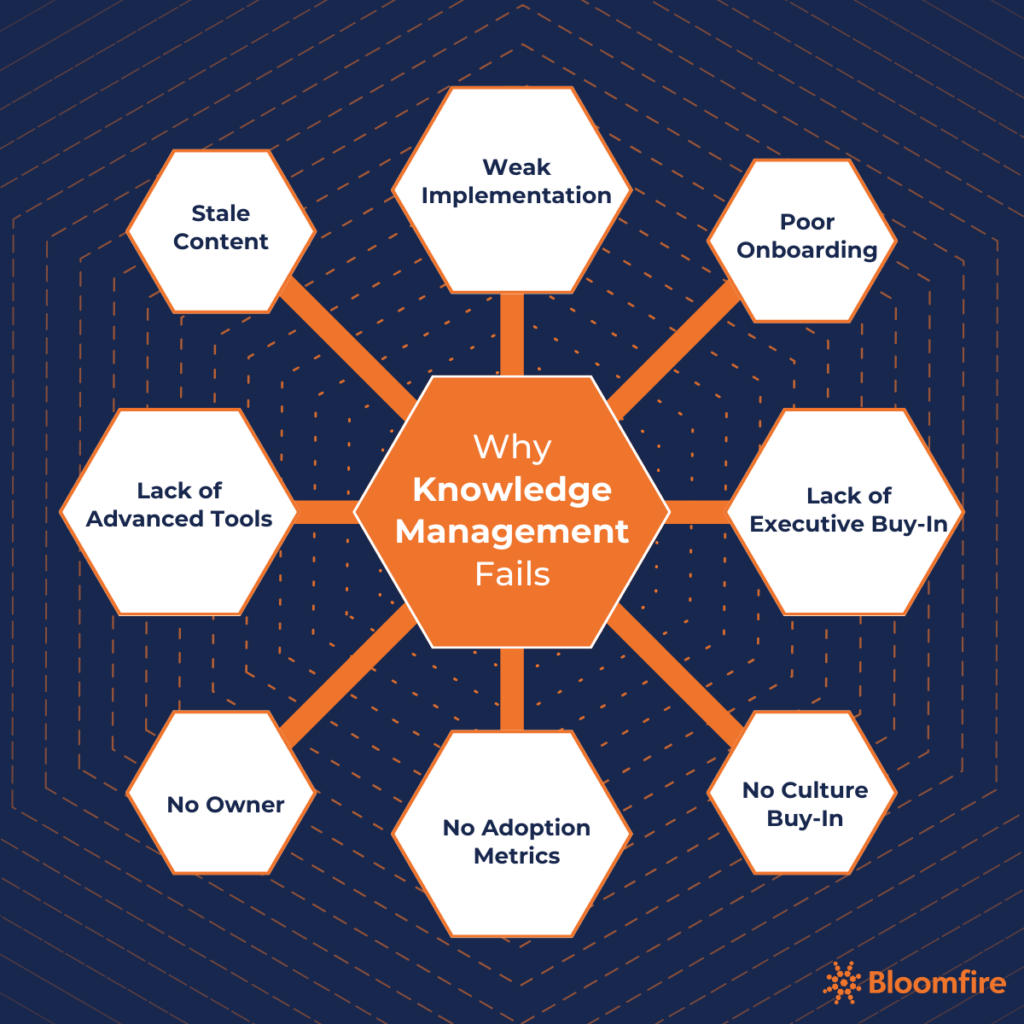8 Reasons Why Knowledge Management Fails

The evolution of digital transformation has been documented over the years. And its trail of adoption gave us the understanding that only about 35% of its initiatives have become successful. That’s quite a scare, but the numbers rarely lie.
Knowing this, you might ask yourself: How do I ensure that any knowledge management technology I introduce is a long-term success?
In answering this question, it’s important to learn about the most common reasons why knowledge management fails. Specifically, the failure to facilitate its implementation and onboarding, lack of leadership and cultural buy-ins, absence of credible owners and adoption metrics, and outdated content.
Let’s look at these seven deadly sins that cause knowledge management initiatives to fail—and how to avoid them.

1. Weak Implementation
Imagine getting an email about a new platform that’s supposed to “make everything easier”—except it arrives without context, training, or a clear plan. Maybe your manager mentioned it briefly, but beyond that? Nothing. Would you really adopt this platform and make it part of your daily routine? Most people wouldn’t—and that’s the problem.
An ineffective implementation strategy is a surefire way to set the new system adoption up for failure. Studies have shown that digital transformation may fail due to insufficient planning, inadequate awareness of its execution roadmap, and lack of transparent communication.
When preparing to roll out a new knowledge management (KM) system, create a strategy for your launch and communicate it to end users. Upload and organize at least 90% of the content before the platform is accessible to the entire company. More importantly, develop a step-by-step strategy, anticipating your employees’ user experience.
Leverage the Power of AI
Did you know that artificial intelligence (AI) incorporated in the KM solution can simplify its implementation? With Bloomfire’s AI-powered smart search, for example, using the system for the first time is as simple as typing your question.
2. Poor Onboarding
Giving employees tools without guidance sets the tone for a system that may not make it off the ground and won’t be sustainable over time. Leaving your employees to figure out how the system works on their own is the hallmark of poor onboarding.
Even when technology is user-friendly, employees are entitled to training and see the product demonstrated. It would further boost their confidence when using the new system and lessen frustrations when dealing with the learning curve.
Streamline the onboarding by planning the training sessions at launch and when new features become available in your KM platform. Find a KM solution vendor to partner with you throughout onboarding and ongoing training. As experts in knowledge management best practices (and their product), they can help ensure employees feel comfortable using the platform and get the maximum value.
3. Lack of Executive Buy-In
If company leaders aren’t bought into a new KM initiative, then why should employees be? A “do as I say, not as I do” approach isn’t going to cut it here. Unfortunately, only 38% of senior leaders worldwide get executive buy-in for new technologies like a KM solution. Thus, it’s no wonder that it has been constantly included in the list of knowledge management failure examples that companies must avoid.
One good way to ensure leadership buy-in early on is to include an executive champion when evaluating, purchasing, and setting up your new KM system. This champion should be someone who recognizes the value of this system and can demonstrate its value to other executives and their teams.
Lead your executive champion to take the modeling approach. For example, you might ask a leadership team member to record and publish a short video explaining their vision for the platform at launch. Subsequently, have them publish a new update on the platform at least once a month.
4. No Cultural Buy-In
Businesses that lack a knowledge-sharing culture will have a more challenging time getting new knowledge management technology to stick. Using a system to facilitate knowledge transfer and collaboration must be built into the company’s cultural foundation. Employees must use the KM platform as part of their daily workflow.
To ingrain the idea and practice of knowledge sharing, consider implementing the following actions:
- Start by making it easy for employees to share knowledge. Initiate the necessary training and provide guidelines and protocols so they can master the new system.
- Establish a sense of psychological safety. People must feel comfortable to share knowledge and feedback without fear of negative repercussions. This atmosphere will encourage them to contribute and collaborate more within and across teams.
- Provide incentives for frequent contributors. These can be shout-outs or small quarterly prizes to further motivate the employees to share knowledge.
Remember that change takes time, and people may need reminders. For example, if you launch a KM solution but still have team members messaging you with one-off questions, encourage them to add the question on the platform (if it hasn’t been answered yet). You can also share a link to a post that answers their question. These will help reinforce the idea that the KM platform is your company’s single source of truth.
5. No Owner
The lack of clear ownership is one of the most common reasons knowledge management fails. Typically, when businesses leave the responsibility to everyone, no one will be accountable, whereas appointing an owner often leads to the platform’s longevity.
The owner (or owners, depending on the size of your organization and initiative) monitors all new content and regularly reviews existing content to determine what needs to be archived or updated. They also work with all department heads to confirm that nothing important is left out.
If your KM solution has built-in analytics, the owner can check who among the personnel is not engaging or using the platform. This can be included in their key performance indicators (KPIs). The owner may recommend additional training or re-engagement tasks to guide inactive or non-compliant users if necessary.
6. Stale Content
Even a strong foundation during KM implementation can rapidly erode without ongoing maintenance. The outdated content in your KM tool will become increasingly irrelevant. This may cause employees to distrust the platform since the answer they uncover is unusable. Remember that 88% of employees get distressed when they can’t locate viable information.
You can maintain content freshness using automated content scheduling, where review reminders are set. Check out this tool when you explore Bloomfire’s content and document management system.
In addition, consider the following practices to keep your content up-to-date:
- Assign owners for categories and specific content and ensure they clearly understand their responsibilities.
- Consider subject matter experts (SMEs) when delegating the ownership roles and align the categories to their areas of expertise.
- Establish the frequency of reviews of the SMEs’ owned content.
Combining the KM platform’s automation capabilities and your strategic appointment of content owners and managers allows your organization to keep content fresh within specific cycles. Thus, the knowledge management platform remains a trusted resource, and the employees will continuously maximize its use.
7. No Adoption Metrics
It’s hard to know what you’re doing well–or not so well–if you haven’t defined what success looks like. If you measure your KM system adoption and engagement, you may fail to see opportunities to optimize the platform.
Before implementing the system, list the metrics aligning with your knowledge management goals. Monitor them periodically to determine whether you’re on the right path or need changes. For example, if you aim to reduce the average time employees spend searching for information, you might send surveys before and after launching your KM platform. Ask the employees to estimate the time they spend looking for information daily.
Resend the survey regularly (like every quarter or every six months) to measure change over time. If you don’t see a reduced time spent searching, this would likely indicate an issue that could point to problems with navigation or poor user experience.
8. Lack of Advanced Tools
Traditional KM systems are mostly confined to their purpose of being knowledge repositories. As a result, companies who choose these platforms often encounter issues like insufficient data storage, file loss, inaccessible content, and so on–problems that new tools can quickly solve.
If you look closely at the advancement of knowledge management technologies, KM platforms have redefined themselves into more than just a digital library. With Bloomfire, for example, employees can use its AI search tool, dynamic content, real-time Q&A engine, and more to speed up and personalize information search. These features improve productivity and reduce hours spent locating helpful content on the platform.
In addition, a Harvard study involving consultants who used AI tools in their work has shown how they completed tasks more quickly by 25.1% and increased work output by 12.2% more. These data support how leveraging new technology can lead you closer to your KM goals as opposed to the dreaded failure of its execution through outdated systems.
Avoiding Knowledge Management Failure
Failure often has more to do with the people and processes surrounding the systems than the systems themselves. Your company can avoid the consequences of poor knowledge management by knowing why knowledge management systems fail and formulating a game plan to address them. Before introducing any new technology, always establish a solid KM strategy.
This blog post was originally published in October 2015. It was updated and expanded most recently in November 2024 to reflect new information and best practices.
Your Roadmap to KM Success Awaits
Get our free knowledge management guide & boost productivity today!
Learn More

How to Improve Customer Service in Call Centers: 21 Ways to Enhance Contact Center Experience

Innovative Ways Companies Are Using Knowledge Management

How to Implement a Knowledge Check in 6 Steps

Estimate the Value of Your Knowledge Assets
Use this calculator to see how enterprise intelligence can impact your bottom line. Choose areas of focus, and see tailored calculations that will give you a tangible ROI.

Take a self guided Tour
See Bloomfire in action across several potential configurations. Imagine the potential of your team when they stop searching and start finding critical knowledge.